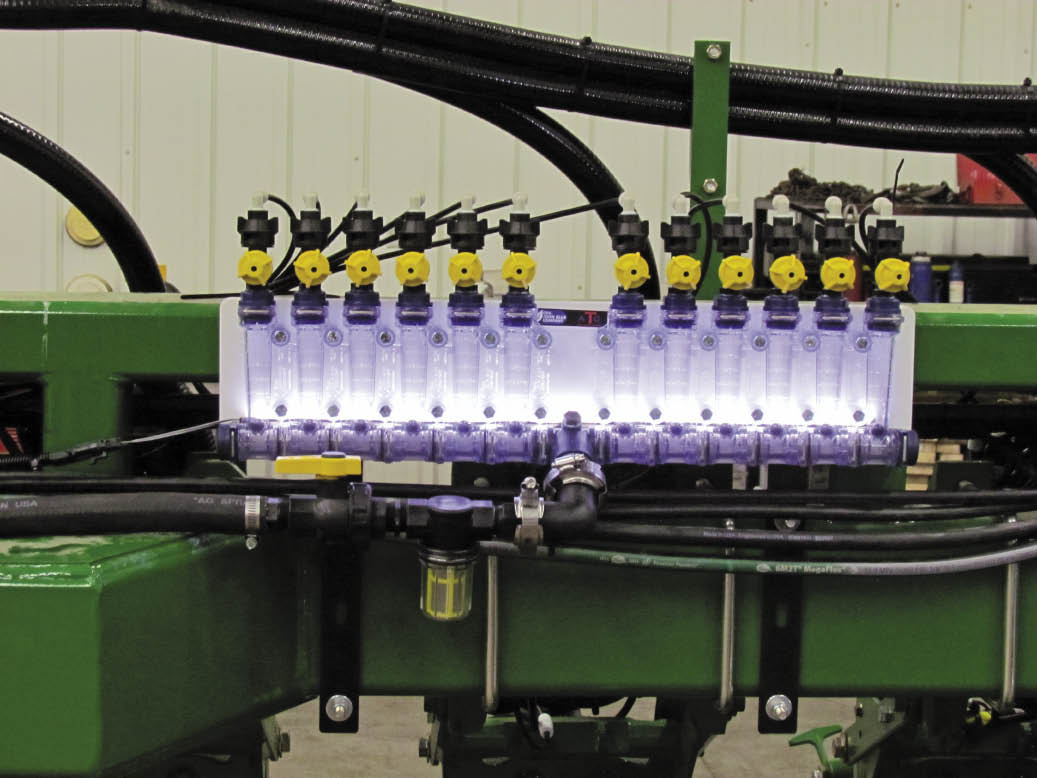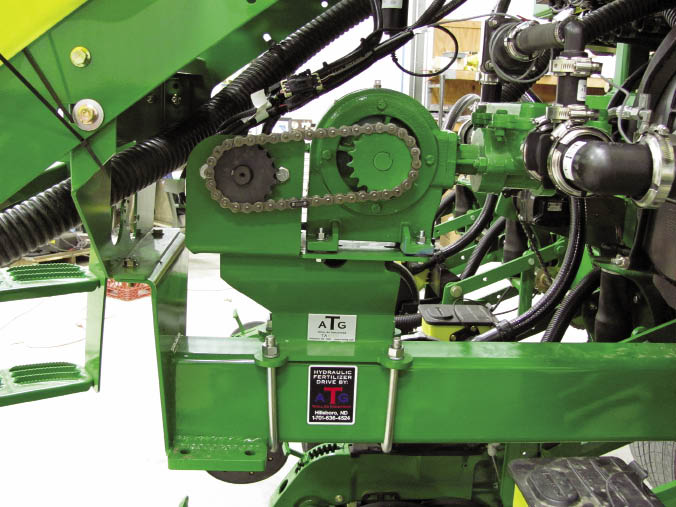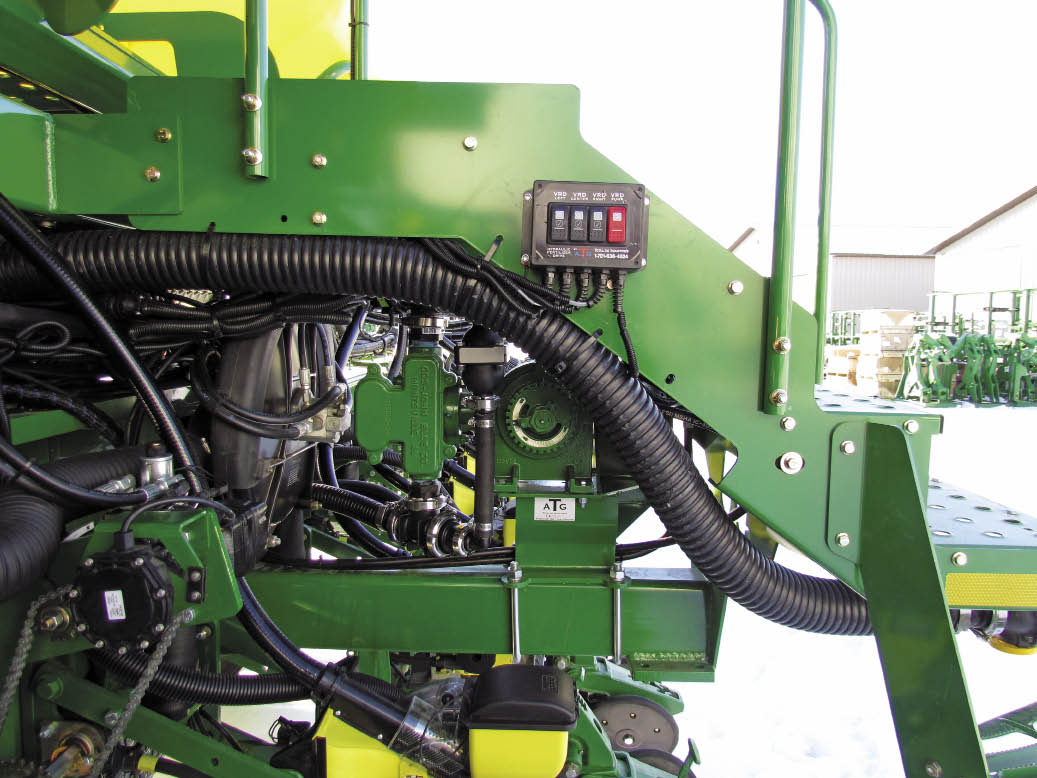Times are good in agriculture, and the technology that drives the equipment has never played a bigger role in making farmers’ jobs easier and more profitable.
Those are powerful reasons for farmers to order brand new machines. However, when demand exceeds supply, buying newer used machines or upgrading current equipment is the only option. Dealers and farmers are finding that aftermarket precision farming equipment can help breathe new life — and greater value — into older equipment. Aftermarket systems can also help introduce cutting-edge technology and in some cases, even sell new machines by giving customers additional options.
Based in Hillsboro, N.D., Total Ag Industries works with eight local John Deere dealers doing factory equipment set-up. It also installs the latest technology, such as variable rate planter systems, on new and used units throughout the U.S. In North Dakota’s Red River Valley, the busy planting season is months away but farmers are already getting ready. Business Manager Justin Risovi and the rest of the staff in Hillsboro have started putting in very long days.
“Every farmer we talk with wants to upgrade his equipment,” says Risovi. “They want to spend the money to keep tools in their lineup that are as advanced as possible.

Working with dealers and farmers, Total Ag Industries custom-builds fertilizer systems and installs them on new and used planters. Above: Back-lit sight-glass flow monitor systems give the tractor operator visual confirmation the fertilizer system is working properly.
“As we see land prices and the cost of inputs increase, farmers are finding they are capped out. A farmer with 2,000 acres knows he will have to do a better job managing every acre to get the most return. He may not be able to spend $5,000 or more an acre to get more land,” he says.
The high cost of expanding the size of their farm has growers looking for ways to earn more from what they already have. “Improving farming practices through the use of precision farming technology, whether it’s with the fertilizer blend or getting row spacing and seed placement down to a science, is one of the best ways to increase yield today,” says Risovi. “With some of this technology, it may cost $5,000 to make $10,000.
“I’d like to think every system we install would give the customer the opportunity to reclaim 100% of the money invested in the components, but most of that has to do with the amount of customization and the dealer’s location. Dealers and farmers have to be smart in knowing what is acceptable in their resale market if you’re planning on trading on a regular basis. Many of the dealers we work with already have customers waiting in line to buy trade-in planters with systems that come from known producers.”
Upgrading New & Used
This year, Risovi says the ratio of used and new equipment they’ve worked on has been 60/40. “We offered early order programs for dealers last June when Deere’s early ordering started. We sent a lot of bids out to dealers to do the set-up, but a lot of that work didn’t pan out.
“The biggest reasons for that was a shortage of new planters and because customers didn’t decide to buy in time, pushing the delivery date out beyond the planting season. We would have seen many more new planters, but instead, guys are buying 5-year-old planters and doing the upgrades. Some farmers bought whatever they could get if it was better than what they had.”

Variable rate hydraulic drive fertilizer systems can provide precise control and accurate application in the field. Total Ag Industries builds the systems with CDS-John Blue components and can install it on most new and used tillage and planting equipment.
While Risovi says he’s had a few customers say they want the bare minimum as far as upgrades go because they’re planning to buy new next year, they still have customers wanting to add variable-rate hydraulic drive kits on planters that are several years old.
New or Used? Know Your Customer
For dealers with access to new equipment, knowing when to recommend an upgrade to an existing unit or buy new can be a tough call. Every customer is different. For a salesperson, knowing a customer’s position in regard to the life expectancy of a machine is important before suggesting an upgrade vs. buying new.
“If a producer has a used planter they’re comfortable with and know it will be on their operation for at least another 5 years they will be willing to spend a lot more, often installing a suite of precision farming components,” says Risovi.
For some growers, buying new simply doesn’t fit into their strategy right now. Opening the catalog of aftermarket solutions makes sense for them, too, says Adam Gittins, precision ag manager for Heartland Technology Solutions’ HTS Precision Agriculture Div. in Harlan, Iowa.
“Maybe it’s technology that’s available on brand-new machines, such as row guidance. Farmers can buy that system or an entire combine with it installed. There are a lot of farmers out there who are not going to buy a new combine just for row guidance. If we can add that aftermarket package to a machine they already have, that’s a much better fit for them.”
“Everyone in production agriculture has benefited from the high commodity prices we’ve seen in the last few years,” says Risovi. “We’re seeing customers who have been running the same equipment for 20 years looking to trade up or add some basic features to non-equipped models. This is one of the best aspects of my job. It’s fun to see a customer get excited when they see a combine they bought new in 1990 use auto-steer and yield mapping for the first time.
“Selling an aftermarket option gives us a larger customer base than we would normally be exposed to, and it can be used as a stepping stone for them to move up to more complex systems as the comfort level of the producer grows.”
Risovi has experienced that with his father. “I talked him into adding auto-steer in his combine, which he had owned for several years. When you’re combining soybeans there’s a lot of dust, which can cause skips and overlaps. He was dead set against it, but I put it on and taught him how to run it.”
His father loves it. “Once, when he lost the signal at the end of the field, he stopped the combine and called me. He knew he could just grab the steering wheel, but he saw the value in having the machine do it because he wanted to keep going straight. When you get accustomed to auto-guidance, you wonder what you ever did without it. Of course, I also stop in the field when I lose a signal, but it’s because I want to make sure all of the work is documented correctly. I’ll spend 5 or 10 minutes getting everything going again before I start up.”
Complicated Equipment Upgrades
“We’re working with a lot of farmers with planters who come into dealerships asking about what kind of options they have for their new or existing units,” says Risovi. “We ask a lot of questions about how much product they want to put down or any other special needs they have. Some farmers in certain localities are after a lot more customization than we have seen in the past.”
Total Ag will send technicians out to a dealership and complete in hours what it might take the dealership days to finish. “The dealer’s techs are not setting up these systems every day,” says Risovi. “Their time is better suited working on a tractor, combine or a sprayer. That’s been valuable to dealers as these systems become more complex.

This electric bypass harness system from Total Ag Industries allows for quick troubleshooting on the planter. Installation includes two, three or four buttons on the rear of the planter depending on its size. A press of the button engages the system for lubrication, priming and winterizing.
When doing installations on older planters out in the field, Total Ag’s team has to be prepared for any situation. They work at their main shop and out of mobile rigs, and carry a large stock of wiring harnesses and complete kits.
One of the biggest challenges they face when retrofitting a variable-rate drive onto an older planter is getting everything to communicate via the tractor’s electronic communication system (known as a CAN bus).
Regardless of what color two implements are, farmers want the machines to communicate. They don’t want 10 monitors in the tractor cluttering up the cab. They want to have the functionality of all of those displays tied into one. While the ISOBUS communication standard will help with that, more work is involved when retrofitting an older planter to run with a new tractor.
“Depending on the model year of the planter, different harnesses may be needed,” says Risovi. “We’ve gotten to the point where we have to stock a variety of harnesses even when we know the model and year of the machine because someone may have already changed or upgraded the electronics. Another option we have is the ability to start from scratch on older machines by adding a CAN bus extension or a backbone harness with power and CAN lines on a machine that’s not already precision-equipped.”
Alternative GPS Options
Derek Davis uses an aftermarket GPS unit to encourage area farmers to trade their green and yellow tractors in for a red and gray machine. Davis works for Agri-Service in Twin Falls, Idaho, a Massey Ferguson dealer with nine retail locations and one independent service location in Idaho, northern Utah and eastern Oregon.
“We have a lot of customers who want to switch tractor brands but don’t want to switch GPS brands, because they spent a lot of money on it,” he says. An auto-steer system from Reichhardt Electronic Innovations, West Fargo, N.D., allows farmers to put their brand of GPS on a Massey tractor. “It’s a nice addition for farmers who won’t lose the investment they’ve already made on their GPS system, and it helps us close deals a little easier,” says Davis.
His first goal is to sell them a Massey Ferguson tractor with a GPS system from AGCO’s own Advanced Technology Solutions division. But, “Where this fits is if a farmer wants the Massey Ferguson tractor but already has a John Deere GPS unit they don’t want to part with. A lot of farmers might shy away from this option. With the aftermarket line we can tell them, ‘You don’t have to. We’ll adapt it.’ It helps us keep the farmer in the showroom a little longer, too.”
In order to move any type of precision farming equipment, it’s vitally important that the dealer is comfortable with the product. “Sales personnel have to know the product and they have to demonstrate it,” says Davis. “If you show it, your close rate is as high as 85%. The grower wants to touch it and see it work.”
Davis says it takes about the same amount of time to install the aftermarket unit as it does one from AGCO. “We order all of our tractors GPS-ready and we make the decision about which system the farmer will use during the initial sale process.”
The system goes right through the Massey Ferguson’s virtual terminal, Davis explains. “Using it is just like going from a PC to a Mac — the functions are similar but the layout is different. There’s a minimal learning curve. We have the technical support in-house to teach farmers how to use it.”

With new implements in short supply, Total Ag Industries is staying busy customizing older units for customers who still want to trade up. Farmers and dealers can fill out a PDF form online to get the process started. The company works directly with growers as well as through dealers.
Agri-Service does the training on the customer’s farm,” he says. “When they’re ready to start working, we jump in the cab and show them how to run it.”
Staying on the Cutting Edge
Throughout the history of the farm equipment industry, features that are taken for granted today, such as pneumatic tires and power steering, were first offered as aftermarket items. It’s still the most effective way to introduce a new product into the market place — once enough customers ask for it, marketing and engineering teams at the OEMs will take notice — and precision farming technology is no different. Ten years ago, auto-steer systems were in their infancy. As more farmers purchased the systems from various companies and installed them on their tractors, manufacturers started offering factory-installed options.
Starting last summer, Heartland Technology Solutions’ Adam Gittins began introducing crop sensors to farmers and dealers, OEMs are not offering that technology from the factory yet. The sensors measure and record data about crops using the reflectance of light shined on the plants. Sensors can be mounted on any type of vehicle to collect information in the field. The data is then used for real-time variable rate applications of nitrogen, for example.
“We work with vendors to help test new products, so I’ll have a year of experience with a product before it hits the market,” says Gittins. “When it’s available we’ll have a good feel for what it can or can’t do. Crop sensors are a new enough technology that we’re working with our most progressive growers first to show them how it can work on their farms.”
Heartland Technology Solutions has found one of the most effective ways to introduce new technology is to demonstrate it. In the example of the new crop sensors, the company purchased a system and starting last summer began installing it on customer’s units so they could run it a couple of days. It’s a good approach for both parties. The farmer gets a chance to see what it would do for him in the field, and HTS gets some real-world field data to analyze.
“This approach makes for an easy conversation with a customer,” says Gittins. “I’m not walking onto their farm trying to sell them something. I tell them, ‘I have something new I want you to try, but I don’t want you to buy it right now.’”
Auto-steer has been around for a while, but Gittins uses the demonstrations for customers who don’t yet have the system. “If you think of a bell curve on the adoption rate of any product, in terms of auto-steer we’re in the middle of the curve. We’re past the early adopters, and yet there’s still a good business in reaching farmers who are not using it. That’s a big share of our business, helping farmers get comfortable with the technology and making sure they’re successful with it.”
On the planter side of the business, Risovi says the biggest trend he’s seen with variable-rate systems is more farmers are adding swath control or planning to apply two inputs in the same pass while planting.
“Putting down two products seems to be regional, but customers from all across the U.S. have been asking for swath control this year,” says Risovi. “I also think having the ability to document an application as it’s happening and using map-based prescriptions gives this system a major advantage over the traditional ground-driven systems.
“We’re seeing a new generation of producers who are not afraid to utilize all of the technical components, and the older generation is growing more comfortable with running more than just auto-steer on their machines.”
Dealer Takeaways
- Farmers are looking to update older machines because of the shortage of new equipment.
- How long a farmer intends to keep a unit determines how much they’re willing to spend on upgrades.
- In-depth product knowledge and field demonstrations are still the best way to sell precision.





